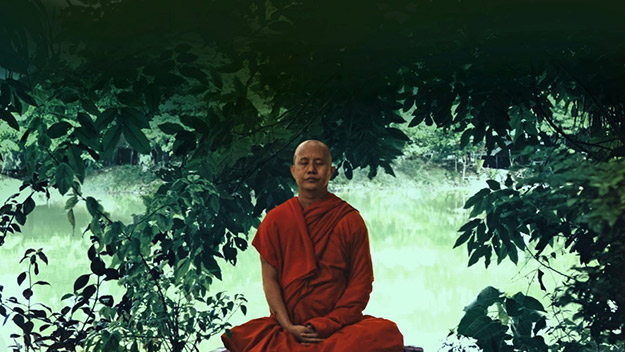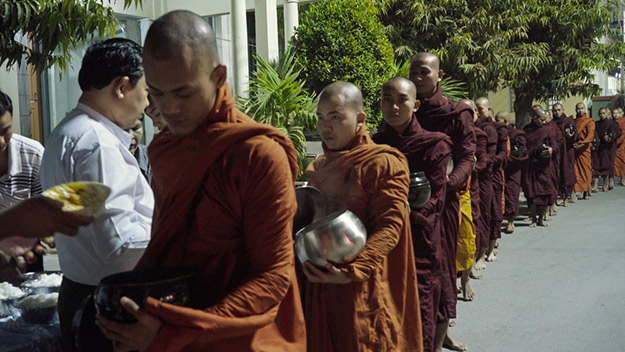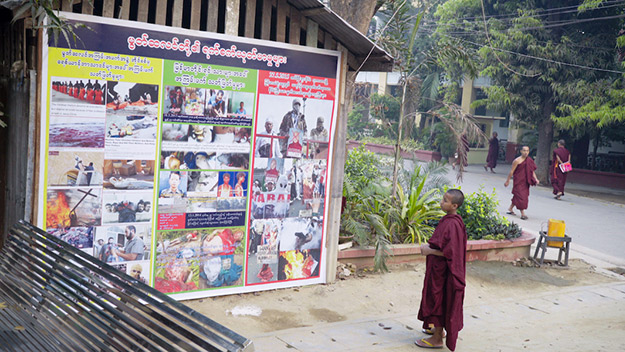Interview: Barbet Schroeder
For the final installment of his so-called “trilogy of evil,” which began in 1974 with General Idi Amin Dada, Barbet Schroeder profiles Buddhist monk Ashin Wirathu—one of the calmly speaking, saffron-robed leaders of the ongoing genocide against Rohingya Muslims in Myanmar. Since the early 2000s, Wirathu—whom Time has called “The Face of Buddhist Terror”—has mobilized Buddhist militias into committing some of the worst ethnic atrocities in Myanmar’s recent history.
As in Idi Amin, Schroeder’s probing, disquieting portrait in The Venerable W. allows his subject to speak for himself—no editorializing is required to drive home the ruthless bigotry of a man who, in the film’s opening scene, compares Muslims to a species of over-breeding catfish. Canny juxtapositions emphasize the film’s central contradiction—the idea of a “violent Buddhist”—but Schroeder is keenly attuned to the fact that this irony is largely a consequence of the Western tendency to paint Eastern religions in broad, fetishistic strokes. As Kent Jones writes in his report from last year’s Cannes, “Schroeder and [editor Nelly] Quettier play a game of concealing information that cunningly exploits Western anxiety over Islam, only to reveal that the Rohingya community is a fraction of the country’s population and that they are spoken and thought of in a manner that recalls the worst of vintage Nazi anti-Semitic propaganda.” The Venerable W. emerges not just as a scathing exposé of the Rohingya massacre and the rhetoric behind it, but also a plea for the Western world to abandon its xenophobic characterizations of Other religions and examine the faith-agnostic origins of evil.
I spoke to Schroeder at the New York Film Festival last September after a screening of The Venerable W. (which remains without U.S. distribution). Since then, increased violence has led to the destruction of entire Rohingya villages in Myanmar and escalated the total number of refugees to more that one million, with half of them stranded in squalid makeshift camps between Myanmar and Bangladesh. Myanmar has recently announced plans to repatriate some of the refugees, but human rights advocates are concerned about the lack of measures implemented to ensure the returnees’ safety. As for Wirathu, he returned to preaching last month after a one-year ban imposed by the state. Unfazed by Facebook’s recent suspension of his page, he said to Reuters, “When Facebook shuts [me] off, I rely on YouTube. YouTube is not wide-reaching enough so I will use Twitter to continue the nationalist work.”
[The Venerable W. screens January 4 to 10 at the Museum of Modern Art.]

As you show in the film, the Rohingya genocide has been going on for a while but it’s only recently been reported widely in the Western press. How did you end up making a movie about it?
It has caught the attention of the press recently, yes, but you have two universities—Yale, and the Queen Mary University in London—both issued 80-page reports in 2015 and 2016 announcing a genocide in Myanmar. When I was reading that, I discovered that Buddhism was involved. I was very attached to Buddhism when I was young, and that rung a special bell for me.
There is a moment in The Venerable W. where a journalist debunks the myth that the Rohingya population in Myanmar is rapidly increasing. Then you cut to a direct address, asking the viewer: “What about the West? What do you think is the Muslim population in your country?” That really reframed the documentary for me as a message, or perhaps a case study, for the West.
I went to Myanmar trying to find out about Buddhism and violence. But once I was there, and time passed, I discovered that I was not making a movie about that—I was making a movie about ourselves, the West, about what is happening to us. The same thing is happening all over the world. Seventy percent of the population in Burma is on Facebook. In a few years, it went from a few percent to seventy. And all the phenomena of populism, nationalism, they’re all identical. Different breeds of it are popping up all over the world, but it’s basically the same.
I read that you managed to get an audience with Wirathu by telling him about Marine le Pen in France.
Yeah! At that time, it was very easy to say to someone that she was going to be the next president. It was less outrageous to say that than to say Trump was going to be president.
There’s even a scene in the film where Wirathu explicitly endorses Trump. That’s really telling, the fact that leaders of ethnic genocides are sympathizing with these politicians.
Yeah, exactly. [Wirathu] keeps himself very informed. He talks about Angela Merkel and what she’s doing. Of course, he’s seeing it from his angle of anti-Islamism. He’s interested in whatever brings water to his river. But those young monks, they’re surrounded by newspapers, they are on the internet, they keep themselves informed.
So they’re really riding a global wave.
Exactly. That’s the disturbing thing.

Speaking of Facebook and the Internet: for me, the most chilling scene in the film is the selfie video taken by the Burmese soldier as his colleagues beat up Rohingya villagers in the background. You use a lot of this type of amateur phone and YouTube footage in the film. How did that influence your process as a documentary filmmaker?
This is a big change, the technical progress of smartphones. For example, when Wirathu took part in his first riot, the first blood that was shed by him was in 2003 in his hometown. He went to jail for that. But there is not a single image of that riot. So I took some pictures of burning houses from somewhere else, and newspaper announcements of the results of the riot. There was nothing else. But then I could see that through the years, the quality was becoming better and better in all the little excerpts.
The quality was extremely bad for [Wirathu’s] first speech, where he says that he’s going to make sure the Rohingyas can’t find any food and have nowhere to sleep. And he’s talking to a thousand cheering monks! This image is grainy, but we decided that we were going to use every image—grainy or shaky. Because in this case, it was essential to understand what the result of the hate speech was. It’s easy to listen to speeches and be shocked, but you have to see the images that are the result of those speeches. You have to see the result at the population level. So we decided, if it’s dramatically strong, if it’s important to the movie, we’ll incorporate it, no matter what the quality may be. And so the movie became an assemblage of all kinds of different techniques and styles of camera.
The figure of a Buddhist fascist is the central contradiction of the film, which you underscore by juxtaposing Buddhist chants with the acts of violence committed by Wirathu and his followers. Is such a figure more contradictory to the Western imagination than in the East? Because there have been other instances of Buddhist-led violence in Southeast Asia, like in Sri Lanka and Thailand. I wonder if this film is puncturing these notions in the West of certain religions being isolated from violence—which then allows people to associate other religions with violence.
This is the way of the world. No one can accept that the word of Buddha can lead to something like that. But you have to think: wait a minute. The words of Christ, what were they? He is the inventor of love in religion—in that part of the world, of course. But you see the Crusades, the torture chambers, the Inquisition… that has nothing to do with the Christ. So you have to be a realist, and realize that there’s a problem with every religion, and there is a problem with everything that’s human. I say Trilogy of Evil… “Evil” is a dangerous word. But at the same time, if you decide that evil is human, then it makes sense.
How has this film, along with the other two films in the trilogy, made you rethink the origins of violence?
Not violence, but it’s definitely made me realize that evil is a part of the landscape of humanity. It forced me to lose my illusions about Buddhism being totally different from other religions. Since it’s a religion without God, so you think there’s no problem. But there still is a problem.

And there’s been so much glorification of Buddhism in the West. You show in the film how the Burmese military uses the Einstein quote, in which he calls Buddhism the “religion of the future,” in their training manuals—but as support for ethnic cleansing based on religion.
As a scientist, [Einstein] thought Buddhism was the religion of the future, since it has no God. And they [the Burmese military] are using that to say, look, Buddhism is great, and Muslims are bad, so you must be ready to be bad with Muslims. That is what this training manual is made for: to condition people like the soldier you mentioned, who is filming his fellow soldiers as they beat up Muslims. Those guys have been conditioned through this presentation. That’s something you have to keep in mind when you see it. I wish that the presentation was more dramatic or revealing, though… Somehow it doesn’t have the punch I was hoping for. You don’t realize, when you see it, that oh my god, they’re making a factory of criminals. It’s a kind of proof. I thought it was very important, the discovery of this thing.
How did you discover it?
Oh… Secret channels that I will definitely never reveal. If I do, someone will get killed. This was something that was definitely not supposed to be distributed out of the army.
What kind of resistance from authorities did you face while making the film?
Well, very simply, after a month of shooting clandestinely, I realized that we were not so clandestine. The military police didn’t just have a dossier on us—they had photos of us. Which means they were serious. They were photographing us every time we were in a Muslim place. It was quite dangerous.
The Venerable W. is not a self-portrait in the style of General Idi Amin Dada, but—
The style is still the same. To allow [the subject] to present himself from a good angle. Like when [Wirathu] says that he was responsible for the 2007 Saffron Revolution. I let him say that, but at the same time I cannot allow false information. So I broke my rules by having someone interject and say that that’s not true. Normally, I would not do that. I would find a way for it to appear obvious without that. But when I’m cornered, and especially when it’s a question of genocide, I have no qualms about breaking my own rules.
Especially when you’re dealing with such a current event. This genocide was going on as you spoke, and it continued after you finished shooting. How did that influence your editing process?
Well, we were including them in the film, but we decided after the first of January that we would not include anything anymore. We had to be ready for the Cannes Film Festival [where the film had its world premiere in May 2017]. So we had to finish somehow. Or else we’d still be there, getting new footage, getting new interviews… It’s endless, unfortunately.

How did you decide on the ending? What did you want it to convey?
I wanted to convey the hopelessness of the situation. We see, at the end, a ragtag army of poor people, barefoot, with some pieces of metal—they don’t even have sabers or guns. And this is supposedly the big jihad insurrection. Well, eventually, it will become that, if the situation is not solved. I wanted to finish on that dark note: that this may lead to more confrontation with the Muslim population. That this is not the end of everything, this is just the beginning. And eventually, someone is going to want to take advantage of the situation, that is the terrible thing.
I was really struck by how violence against women is used both as a justification for war and the means of war. Like that propaganda video Wirathu has produced, which graphically re-enacts the rape of a Buddhist woman.
That is one of the really telling moments of the movie, I think. When you see that, suddenly a big black hole opens up in the movie. It reveals so much. It reveals that [Wirathu] knows that using violence in the images will impress upon children, upon everybody. And that the uglier the images you put, and attribute them to Muslims, the better it is going to work. Actually, the Rohingyas are doing that, too. Showing horrible images and saying, look what they did to us. But they shouldn’t be resorting to making things look different from what they are, because the reality is 10 times worse.
[Wirathu] likes to use those kinds of violent images for his propaganda. He is aware that every time there is a problem, there is a rape associated with it. You don’t know if the rape was invented, or if they were just waiting for news of it. Actually, I asked him a question, the only point where I was a little different in my questions. I asked him: do you think there are Buddhist men who are raping Muslim girls? Do you think they exist? And he was going to say no, but then he caught himself and said, “Yes, of course. Of course it is possible to have Buddhist men raping. It can happen, of course. It won’t happen often, but it can happen.”
But you know, I almost cornered him there. Because of course, what he thinks, and what he makes everybody believe, is that the Muslims are all rapists and the Buddhists are not. But rape exists all over the world. Everywhere, in every culture. What is absolutely horrifying is the weaponization of rape. That is a totally different story—there is no desire there. This is a technique, a strategy. You take all the women, old and young, and you rape them. And just like that, you destroy society. Especially in a society where there’s a lot of shame associated with that, you really destroy the structure of the social tissue. And this is very cleverly planned and done. In Burma, there was an essential study in 1970, on how the army was doing exactly that with the Shan population. The Shan Women’s Association published a 100-page report, where you can see every rape, where it was committed… they documented everything. It was impossible to disprove.
So you have this study that shows that this was the tradition of the Burmese army. And now Aung San Suu Kyi says her father was in the army, and that all those stories of rape are fake. On her site, she says “fake rape.” For me, that is too much. Too much.
Devika Girish is a freelance film critic based in New York.







